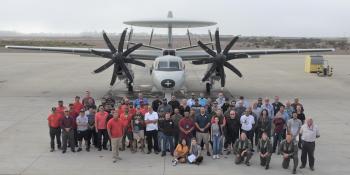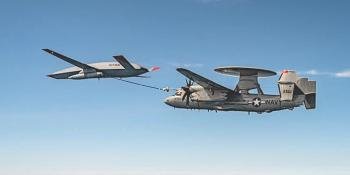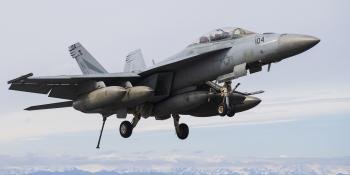The USS Gerald R Ford is the largest warship ever constructed and is named in honour of the 38th President of the United States, Gerald R Ford, who served as an assistant navigator on the USS Monterey in the Pacific Theater between June 1943 and December 1944.
The Ford was delivered to the US Navy on May 31, 2017 and embarked on its first full-length deployment on May 3, 2023. Since sailing from Naval Station Norfolk, the aircraft carrier and its associated units have taken part in NATO drills in Norwegian waters and the Arctic ocean, including BALTOPS and Arctic Challenge. From there, the ship and its 4,500-strong crew sailed to the Mediterranean in late June. During the same month, a detachment of F/A-18E/F Super Hornets and EA-18G Growlers from the USS Ford took part in Exercise Air Defender 2023, operating from Hohn Air Base, Germany.
It remained here and in the nearby Adriatic for the next three months, and was visiting Trieste, Italy as Aviation News went to press. The author embarked on the Ford from Naval Air Station Sigonella, Sicily via a Grumman C-2A Greyhound as it sailed between Italy and Greece.

The ship’s commanding officer, Capt Rick Burgess – a former TOPGUN instructor with more than 3,500 hours on the F-14, F-15, F-16 and F/A-18 – welcomed the party aboard by detailing the new capabilities of the Ford, and the improvements made from the earlier Nimitz class carriers. He explained: “Nimitz-class legacy systems have been updated and upgraded to take advantage of automation and improvements to reduce maintenance and improve our warfighting effectiveness. Because of the technologies on Gerald R. Ford, the crew can load and launch aircraft faster than ever before. The electromagnetic aircraft launch system (EMALS) and advanced arresting gear (AAG) mean Gerald R. Ford is designed to offer an increased sortie generation rate over the Nimitz-class, and its in-deck refueling system and smaller island, which has also been moved further aft, opens up more ‘real estate’ on the flight deck to move, stage and refuel aircraft.

“These technologies foster the interoperability and high-end skill sets required by today’s strategic realities. Ford-class carriers are designed to generate a higher sortie rate with a 20% smaller crew than a Nimitz-class carrier. This translates into savings of approximately $4 bn per ship in life-cycle operations and support costs, compared to the earlier Nimitz class.
To get an understanding of this tempo, Capt Burgess added: “[Since the start of this deployment], we’ve participated in several high-end military exercises and operations, ranging from the Arctic and High North down to and across the entirety of the Med’, and we’ve supported ten allied and partner nations along the way... In just 44 fly days, Gerald R. Ford sailors safely launched and recovered 3,761 aircraft.

Carrier Strike Group 12
The Gerald Ford is the flagship of Carrier Strike Group 12 (CSG-12), one of four US Navy carrier strike groups assigned to the United States Fleet Forces Command. The mission of a CSG is to gain and maintain sea control as well as projecting naval airpower ashore. Aside from the carrier, CSG-12 comprises two Ticonderoga-class cruisers – the USS Vicksburg and USS Normandy, Carrier Air Wing Eight (CVW-8) and Destroyer Squadron 2, a package of six Arleigh Burke class destroyers – the USS Stout, USS Mahan, USS McFaul, USS Oscar Austin, USS Bulkeley and the USS Mason. Command of the CSG passed to Rear Admiral Erik J. Eslich on May 24, 2023 while the USS Ford was at anchor off Oslo, Norway.

Carrier Air Wing Eight is the airborne component of CSG-12 and is composed of nine units which operate a mixture of rotary and fixed-wing assets designed to allow for broad striking power hundreds of miles from the carrier’s position, while providing defense in depth of the strike group through early warning and detection of airborne, surface and subsurface targets.
CVW-8 was assigned to the Ford in 2022 and accompanied it on its shakedown cruise in October of that year, as well as the more recent deployment to the Arctic and Mediterranean.
Currently, the ship is not cleared for the Lockheed Martin F-35C Lightning II to operate from its flight deck, with modifications required to make this a reality scheduled for fiscal year 2025. The future USS John F Kennedy will become the first ship of its class to receive the Lightning II. Therefore, the present day tip of the GRF’s spear comprises a quartet of Boeing F/A-18 Super Hornet-equipped strike fighter squadrons - VFA-31 ‘Tomcatters’, VFA-37 ‘Ragin Bulls’, VFA-87 ‘Golden Warriors’ and VFA-213 ‘Black Lions’ – which can be identified by its VFA prefix which stands for ‘Vessel, Fighter, Attack’.

The first three of these units all fly the single-seat F/A-18E, whereas VFA-213 is equipped with twin-stick F/A-18F Super Hornets. The latter variant is used for both training and high-workload missions where the second crewmember can help to split the workload during a mission. Two-seat version replaced the F-14 Tomcat and, as well as fulfilling the roles assigned to the ‘E model, performs air intercept, Combat Air Patrols and air-to-air refuelling missions. The Super Hornet forms the basis of another type which flies from the Ford, the E/A-18G Growler. Five Growlers assigned to Electromagnetic Attack Squadron 142 (VAQ-142) ‘Gray Wolves’ serve in the electronic warfare role.
Two variants of the Sikorsky MH-60 Seahawk – the ‘R and ‘S – also form part of the CVW-8 package. The first of these, the MH-60R, is flown by Helicopter Maritime Strike Squadron 70 (HSM-70) ‘Spartans’ and has been optimised for the anti-submarine warfare role and its Seahawks can be distinguished by the large radar dome fitted on the underside of the fuselage. The other MH-equipped unit, Helicopter Sea Combat Squadron 9 (HSC-9) ‘Tridents’ operates in a much broader role, being tasked with Anti-Surface Warfare (ASUW), Combat Search and Rescue CSAR, Search and Rescue (SAR), Special Operations (SpecOps) and Vertical Replenishment (VERTREP) missions.

The final two units, Airborne Command & Control Squadron 124 (VAW-124) ‘Bear Aces’ and Fleet Logistics Support Squadron 40 (VRC-40) ‘Rawhides’ both operate Grumman-designed and built aircraft. The former flies the Northrop Grumman E-2D Advanced Hawkeye and is responsible for airborne early warning and control taskings. The ‘Rawhides’ serve in the carrier on-board delivery role using the venerable C-2A Greyhound – a type soon to be replaced with the CMV-22 Osprey.

Flying from the Ford
From a pilot’s perspective, the most noticeable operational difference between Ford and Nimitz class carriers is the replacement of steam-powered catapults with a new electromagnetic aircraft launch system (EMALS) which uses stored kinetic energy and solid-state electrical power to assist departing fixed-wing aircraft.
When asked about the differences between steam and EMALS systems, an F/A-18 Super Hornet pilot who wished to remain nameless, said: “Landing on USS Gerald R. Ford is similar to landing on any other aircraft carrier in the fleet. The differences are entirely housed under the flight deck's surface, which are largely unnoticed by the aviators using the systems operationally. I execute my mission, tasking, takeoffs, and landings exactly the same way, whether we use steam or magnets to launch.”
The seamless transition from steam to electromagnets used to get aircraft airborne is reflected in the AAG system, which allows for the recovery of a broader range of aircraft while reducing the fatigue-impact load on an airframe, thus lengthening its service life.

The transition from Nimitz to Ford class aircraft carrier is clearly a matter of evolution rather than revolution, with the latter based on the former’s hull. However, the incorporation of new technologies and the revised flight deck, among other advancements and improvements discerned from more than four decades of Nimitz operations, will surely provide a revolution in US naval air power once paired with the F-35C Lightning II.





